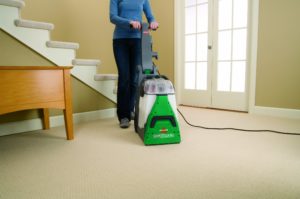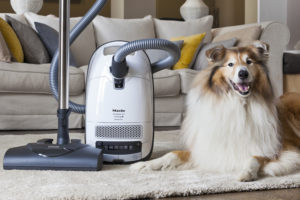
If you’ve got allergies or asthma, you’ve probably been advised to stay away from carpets. As the story went, carpets were seen as allergy magnets, and the fact that they held allergens would inevitably lead to worse symptoms than what you’d experience in a home with hardwood or other bare floors. However, there is a growing body of research suggesting that the old advice was wrong, and that the truth might actually be the reverse. In other words, studies are showing that carpet may be one of the best ways of managing allergies in a home, apartment, condominium, or other indoor living space.
German Allergy and Asthma Society notes the benefits of carpeting for allergy management
Our first bit of evidence comes from Germany. DAAB, or the Deutscher Allergie- und Asthmabund (the German Allergy and Asthma Society), ran a study on the effects of carpeting when managing airborne allergens; they published their results in February 2005 in Allergie konkret, their bimonthly magazine on allergy management; you can read an English translation here via the Australian Carpet Institute. Aside from the interesting fact that in Germany, 64% of homes have bare floors while 36% feature wall-to-wall carpeting, this is the most relevant part:
The core result of the study is, however, clear: In a room with a bare floor, the risk of more airborne fine particulate rises, while the use of wall-to-wall carpeting minimizes this risk. This means that for especially sensitive people whose airways are already damaged, it is an essential preventive measure to select a floor covering that binds dust and does not release it into the air.
The study goes on to note the deleterious effects of fine dust as well as allergens, and how allergens that become airborne (such as cat allergens that leave cats while they lick their fur) bind to dust particles which then find their way into the lungs and lead to acute and chronic health issues. They suggest that indoor air, which is the air we spend 90% of our lifetime breathing, does not receive enough attention when developing standards and limits for air pollution.
In the study conducted in German homes, they additionally mention how the average concentration of fine particulates in homes with bare floors was nearly 63 micrometers per cubic meter, significantly above a limit established by an EU Directive 1999/30/EG of 50 micrometers per cubic meter. In households with full carpeting, in contrast, the average particle concentration dropped to 30 micrometers per cubic meter, well within recommended limits.
Housing characteristics, reported mold exposure, and asthma
A second study from Europe, conducted as part of the European Community Respiratory Health Survey, looked for a connection between home characteristics tied to a variety of factors (e.g., floor coverings, mold exposure, dampness, and level of house dust mites) and symptoms of asthma in adults. The study involved 18 countries and a population of approximately 19,000 people, and the results are available here via the Journal of allergy and clinical immunology. In brief, they found…
Fitted carpets and rugs in the bedroom were related to fewer asthma symptoms and bronchial responsiveness. This effect was consistent across centers and more pronounced among house dust mite-sensitized individuals.
In other words, their results mirrored those of the German study; carpeting was associated with fewer allergic responses, not more. The take home message is that if you want to reduce allergens in your home, you don’t want hardwood floors, tile, vinyl, or laminate, as beautiful and aesthetically pleasing as you might find them: you want good-old fashioned, wall-to-wall carpeting. We’ve often stated that carpets are the largest air purifiers in your home, and articles like these continue to confirm our hypothesis.
To reduce carpet allergens, you need to vacuum and clean your carpets frequently
No matter how much carpet you have in your home, it’s not going to completely eliminate allergens. You still need to keep your carpets clean, which means frequent vacuuming and deep carpet cleaning. This goes for all residential carpet styles (e.g., Saxonies, berbers, friezes, and cut and loops) as well as all fiber styles, whether synthetic or natural.
Generally, the higher your carpet pile, the more allergens it will trap, as thicker piles (i.e., those with longer fibers) will have more surface area. The same goes for higher density carpets and soft carpets. The take home point is that having a regular cleaning schedule and quality machines to get the job done will help keep your carpet–whatever its style–working at full capacity as an allergen trap. Next we’ll take a look at which machines are most efficient at maintaining carpets.
Which carpet cleaners and vacuums are recommended for allergy management?

While the mere presence of a carpet will have beneficial effects for allergy and asthma sufferers, per the studies above, the cleaner you keep the carpet, the more allergens it will be able to absorb and the better the air quality you’re likely to enjoy in your home. For deep cleaning, we typically recommend the Bissell 86T3 Big Green. It has the power to remove a wide range of deeply set stains and soiling events, and will do so as well as any industrial or residential machine under the $1,000 price point.

As with deep carpet cleaning, the more you vacuum, the more allergens you will pull from your carpets, allowing your carpets to more efficiently absorb airborne allergens when you aren’t vacuuming. We recommend heavy-duty canisters with whole machine HEPA or charcoal filtration and the ability to handle carpets of a range of piles and styles. In our books, the best options include the Miele Complete C3 Cat & Dog and the Miele Compact C2 Electro+. The Cat & Dog is particularly adept at handling pet allergens and both will clean both carpets and hardwood floors with ease.
![]() You can buy the Bissell 85T3 Big Green carpet cleaner here on Amazon. You can buy the Miele Complete C3 Cat & Dog here or buy the Miele Compact C2 Electro+ here.
You can buy the Bissell 85T3 Big Green carpet cleaner here on Amazon. You can buy the Miele Complete C3 Cat & Dog here or buy the Miele Compact C2 Electro+ here.
![]() Canadians can buy the Miele C3 Cat & Dog here, the Compact Electro+ here, and the Bissell Big Green here.
Canadians can buy the Miele C3 Cat & Dog here, the Compact Electro+ here, and the Bissell Big Green here.
 If you find our research on PMC helpful, you can follow our efforts to keep maniacally reviewing home cleaning tools by shopping through our links above. We promise to keep fighting the good fight against every horror children, animals, and grown, yet messy humans can inflict upon a clean home.
If you find our research on PMC helpful, you can follow our efforts to keep maniacally reviewing home cleaning tools by shopping through our links above. We promise to keep fighting the good fight against every horror children, animals, and grown, yet messy humans can inflict upon a clean home.

